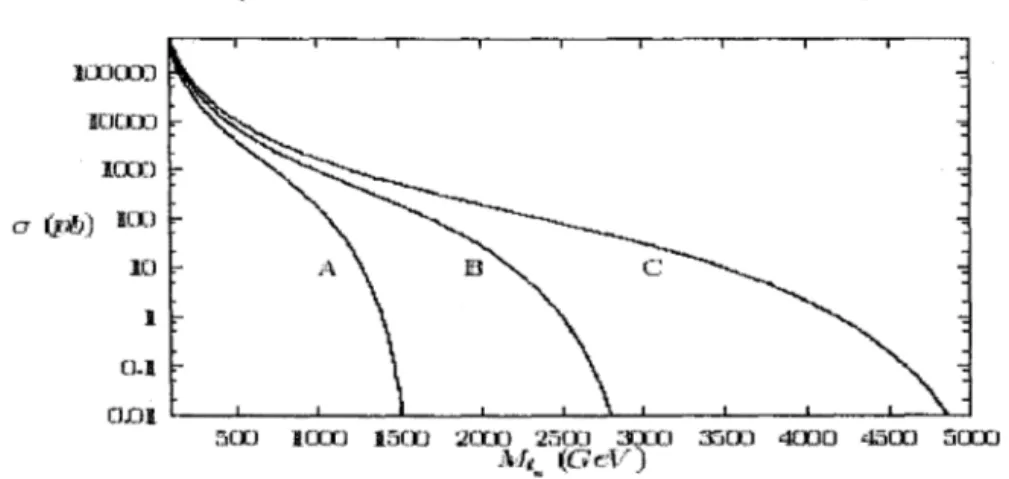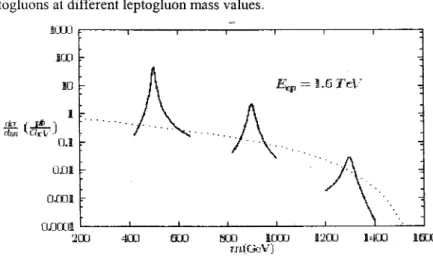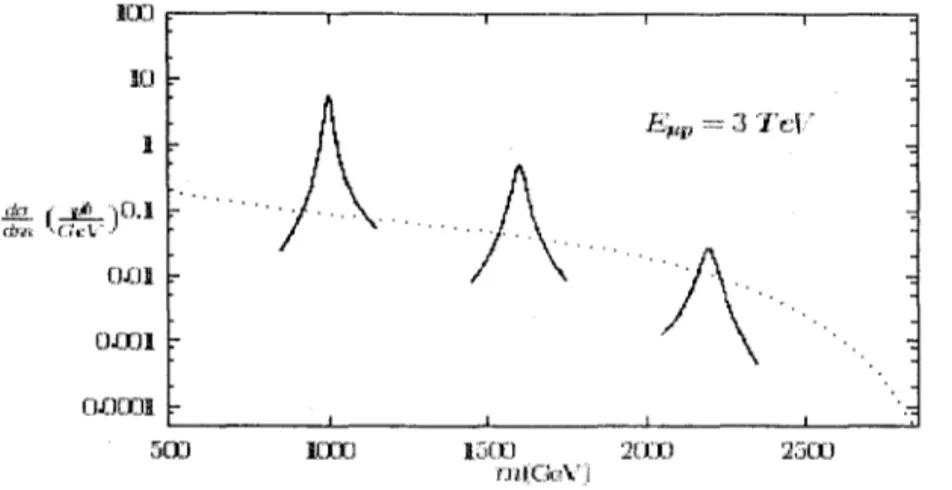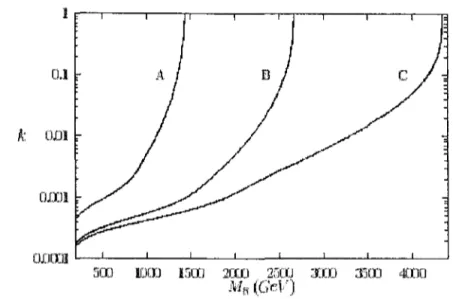Corumun. Fac. Sci. Univ. Ank. Series A2-A3 V. 47. pp.7-19 (2003)
SEARCHING FOR COLOR OCTET LEPTONS IN LEPTON-HADRON COLLISIONS
M. KANTAR
Muğla University, Faculty of Arts and Sciences, Department of Physics, Muğla, TURKEY
(Received Aug.15,2003; Revised Dec.26, 2003; Accepted Dec.30, 2003)
ABSTRACT
We study the resonance production of color octet leptons /8 predicted by composite preon models of leptons and quarks at lepton-hadron colliders such as TESLA x HERA, µp and Linac-LHC with the energy ofabout 1-10 TeV. The numerical results for /8 cross sections are obtained from s and t channel diagrams. We also give the discovery contour for /8 production in the
k
XM
1, plane at these machines.1. INTRODUCTION
Recently, in theoretical and experimental particle physics, many works which explore the answer of a fundamental question: "What is the smallest constituent of matter?" have been made. The present appearance of these works is much more promising. Some experimental results which show the truth of many predictions in partide physics force the physicists rightfully to study in this direction. At present, the high energies and high luminosities to be reached at particle accelerators enable us to some possibilities to research new physics beyond the standard model.
As the fundamental problems of Standard Model such as lepton-quark symmetry, family replication, mass hierarchy problem, charge quantization, ete., it seems to be more natural to go beyond it. Today, SUSY [1,2,3] and compositness [ 4,5,6] remain alone as the most promising candidates for underlying physics.
Because of too many arbitrary parameters (more than two hundreds in the case of three SM families [7,8,9]), MSSM does not look like a realistic theory. Nowadays, SUGRA could not achieve to give natura! description for mass spectrum and mixings of SM fermions and their SUSY partners either. Consequently, the compositness stays alone as a radical candidate for the next scale physics. It is also natura! to expect SUSY to be realized at most fundamental, very likely pre-preonic !eve! [1 O].
Many attempts [ 4,5,6] and references therein) have been made to search the fundamental building blocks of quarks and leptons. None of the composite models has taken an experimental support yet, although family replication and CKM mixings can be considered as an indirect manifestation of SM fermion's substructure. However, the new experiments with higher energies will provide direct access to shorter distances and composite structures will hopefully be revealed.
At this point, it will be helpful to compare between future collider energy
and compositeness scale A. There are three
options: i)Jf « A, ü)Jf
~
A,iii)Jf
» A. in the first case, compositeness induced contact four fermion interactions of SM particles have usually been considered, since one expects that the masses ofnew particles !ay in the order of A. However, as in the flavour democracy approach [11,12,13,14] of SM, the masses of some new particles might be far smaller than A. A zoo of the new particles and interactions will appear whenJf
» A . in the third case, predictions become strongly model dependent. According to recent data taken from CDF and DO experiments at Tevatron, the lower mass limits for leptogluons is about 86 GeV [15] and for leptogluon neutrinos 110 GeV [16]. These mean that there is no experirnental support for lepton cornpositeness.SEARCHING FOR COLOR OCTET LEPTONS IN LEPTON-HADRON COLLISIONS 9
2. LEPTON-HADRON COLLIDERS
Nowadays there are many studies on Lepton (Photon)-Hadron Colliders [17,18,19]. The parameters of center of mass energy and luminosities for lepton-hadron colliders which have been planned to design at several countries are given in Table 1.
Table 1. Energy and luminosity parameters of some lepton-hadron colliders [19]. E.(TeV Ep(TeV ✓s(TeV) L(l0jucm-ıs-1)
0.25 1.0 1.0 10
TESLA x HERA 0.5 0.5 1.0 50
0.8 0.8 1.6 25
µp 1.5 1.5 3.0 100
Linac-LHC 1.0 7.0 5.3 500
The investigation of physics phenomena at extremely small x but high
Q2
(> 10 Ge V2) is very important for understanding the nature of the fundamentalinteractions at all levels from atoms to quarks, or more constituent levels like preonic level. At the same time, the results from lepton-hadron colliders are necessary for adequate interpretation physics at future colliders.
Construction of future lepton linacs tangentially to hadron rings (HERA, Tevatron and LHC) will provide a number of additional opportunities to investigate hadron interactions at TeV scale. As seen in Table 1, Linac-LHC is lepton-hadron collider which has the largest energy and luminosity when compared to the others. it is widely possible to search for new particles predicted by some composite models [20,21,22] at these machines.
3. RESONANCE PRODUCTION OF LEPTOGLUONS 3.1. Leptogluons
Leptogluons are colour-octet states carrying lepton number which can have dimensionless renormalizable couplings only to gluons. In some works [23,24,25,26,27,28,29], we have seen that leptogluons can be constructed by a global SU(N) x SU(M) hyperflavour symmetry belonging a preon lagrangian, where N is the number of fermionic preons a and Mis the one ofbosonic preons (x, y).
in this section, we want to give their production mechanism and some decay modes. According to our model [30] predicted for lepton and quark compositeness, leptogluons can naturally arise from a bound state ofa colour triplet fermionic preon and a colour anti-triplet scalar preon in the fermion-scalar model of leptons and quarks. Therefore, these particles can decay into a lepton and a gluon as
v8 ➔ ı,g e8 • eg
or a lepton and two quarks as
v8 • vdd, ude; e8 • viid, uue
in our calculations, we restrict ourselves to two particle decays of leptogluons. Transitions between the colour octet leptons (18) and the ordinary lepton (l) may take place via the dimension-5 interactions [31,32,33]
L =-1-IYsagsGa µvaµv(IJL!L +IJR[R)+h.c.} (1) 2A 1
where l denotes charged leptons and neutrinos, a runs from 1 to 8.
gs
stands for QCD coupling constant and A is the compositeness scale. Ga µv is the gluon fıeld strenght tensor.lh
and'7
R are the chirality factors for left- and right-handedleptons. The leptonic chiral invariance implies that IJLIJR =O. We choose IJL
=
1 and 77 R=
O in our calculations. According to this lagrangian the decay width ofSEARCHING FOR COWR OCTET LEPTONS IN LEPTON-HADRON COLLISIONS 11
asMı 3
r(l8 • lg)
=
8 (2)4A2 3.2. Production Cross Section
At TESLA x HERA, e-type leptogluons e8 will be produced in resonance
mode via lepton-gluon fusion in the s-channel as Xmax
c;(ep • e8X)
=
f
dxcr(xs)Jg(x) (3)Xnıin
where fg (x) gluon distribution function in the proton. xmin
=
M2 es / s andXmax
=
1 .
In the narrow width approximation the cross section of the s-channelleptogluon resonance production can be obtained as
Xmax 21r 2 M 2
c;(ep• egX)""
f
dxfg(x)-ö(x--es-)Xmin S S
(4)
The total cross section for resonant e-type leptogluon /8 production at TESLA x HERA is plotted versus the mass of color octet electron in Fig. 1.
l(XlOOJ ıocm ıın:ı a ip!)) ıo:ı 10 l 0-1
50:J ICOJ 1500 2CUJ 25(D ::lXO ;;15O:J 40'.J0 45o:J 50CO AJ,. (GcV)
Figure 1. Total cross section for resonance /8 production at Lepton-Hadron colliders. Curves A, B and C correspond to machines TESLA x HERA, µp and Linac-LHC, respectively.
We have also plotted µ8 cross section versus its mass at µp collider represented curve B and e8 cross section versus its mass at Linac-LHC collider represented curve C. Hereafter, we use parton distributions from the ref. [34].
C. Signal and Background
The differential cross section ofleptogluons can be easily obtained as
( : ~ ) Signal
=~ı-k
2g;
4(t,
/:i
2 2r ,
st
3 2 2]!
(5) ı Ig• Ig 16ırs 4ı\ (s-M18 ) +M18r
(t-Mı8 )where
s,
i
andu
(seen in Eq.(7)) are Mandelstam variables for the subprocess. By choosingk
=
1 ,
we set the value of /ı. = M 18 in some of our calculations, which means that we concemate ourselves in the region of compositeness scale A. W e also calculate the discovery contour of leptogluons ask running from 0.0001 to 1.There won't be any interference terms to lepton-gluon interaction from SM background processes. On the other hand, there are main contributions from the standard model background processes in lepton-jet channel such as
l + q • l + q, l + q • v + q'. The differential cross section of SM background processes in the lepton-jet channel is given by
(1
ul
2ı uı
2
J( •2 ,, '2}
e
e
u u( ,,
'2)~
gw
2
!Qıl ,2
x Cv + C A 2s + 2st + t - 4Cv C A Cv C A 2st + t ~+ , 2 2 s 4(t -Mw )
+g/g/QuQı
" 2re
t
Vr?c
Vu•
\ 1ıs
2
+ısi+i
2
)-ıc
Ae•c
Au•
1\ısi+i
2\l
}jt(t -M z )
SEARCHING FOR COLOR OCTET LEPTONS iN LEPTON-HADRON COLLISIONS 13
where Qq, Q1 are the charges ofu and d quarks and leptons, respectively.
Cvj
and C v ,A q are the vector and axial vector couplings in the GWS Model.
g
e is thecoupling constant of electronıagnetic interactions, gz and gw are the coupling constants of the weak interactions. M z and M w become the masses of the Z and W bosons, respectively.
r
stands for the decay width of leptogluon, Qu is the element of CKM matrix for i and j quarks.Another variable that is often used in studies of single jet production is the lepton-jet invariant nıass m. in resonance case, this is easily shown to be given by
(7)
for the SM background processes and
da
=
2m Ô'(s)fu(!!!_)( )
Signal 2
dm s s (8)
for the signal processes.
The subprocess cross section
ô-(s)
for the SM and signal processes can be easily obtained from Eqs. (4) and (5) aslmax dô- , , , '
a(s)=
J -,
(s,t,u)dt.t mm . dt
4. NUMERICAL RESULTS
(9)
According to the results from our calculations, it is posibble to see some signals that the leptons could be cornposite objects. Particularly, if the compositeness scale for leptons is about 1 TeV, we can most probably see this at
TESLA x HERA collider when it starts running. The total cross section for
leptogluon production versus the nıass of leptogluon is plotted in Fig. 1. in Fig. 1 curve A tells us the e-type leptogluons can be investigated up to the nıass value of
1.43 TeV at TESLA x HERA collider with the integrated lurninosity of 5xl02 pb-1 by taking 100 events per year for the discovery of leptogluons. Similarly, we can expect the same behaviour for µp (curve B) collider up to the rnass value of 2.69 TeV with the integrated lurninosity of 103 pb-1 and for LHC-Linac (curve C)
collider up to the mass value of 4.79 TeV with the integrated lurninosity of 5 x 103 pb-ı . in Figs. 2, 3 and 4, we plot the invariant mass distributions for
leptogluons at different leptogluon mass values.
ım ıo ı ria (J!!_ 'J clr.ıı -Gc\/. o.ı O.Ol o.mı o.ı:ıu::ıı
.__ _ _
.__ _ __..__ _ __. _ _
~~~~--~--~:.ıu::ı ru:ı KD lCOJ 12(.lJ l'1W
rn.:u
m(GiV]Figure 2. At TESLA x HERA, invariant rnass distribution ep • ljX. Resonance peaks are shown for M eg = 500,900 and 1300 GeV, respectively. Dotted line denotes
SEARCHING FOR COLOR OCTET LEPTONS iN LEPTON-HADRON COLLISIONS 15 lOJ . , . . . - - - ~ - - - , - - - ~ lO l O.Ol 0.(J()l -o.ı::ıo::ıı -;'.j()J 1 ıaxı 1 1 1 ı;:,o:ı 2UD 23[0 rnl,Gı:1\·1
Figure 3. At
µp
collider, invariant mass distribution µp •IJX .
Resonance peaks are shown for M µg=
1000,1600 and 2200 GeV, respectively. Dotted line denotes the SM backgrounds.o.ı
omı
ODCfi'---'--..___,__.__'-~'---''----'---'-~-'
50J ıcro ı::im
2cm
:ı:füJno
l':iOJ 40JJ '150J :ıı:mm(GrV)
Figure 4. At Linac-LHC, invariant mass distribution ep •
IJX .
Resonance peaks are shown for M es = 1500, 2500 and 3500 Ge V, respectively. Dotted line denotes the SM backgrounds.in our calculations, we ignore the contributions coming from t-channel diagram because of the leptogluon propagator term, and only take into account the term coming from s-channel diagram. The peaks appearing in the figures show that the expected number of events for signal will be more when compared to the background events.
Finally, we give the discovery contour for leptogluons in terms of its rnass and a new coupling parameter k for the rnachines TESLA x HERA, µp and Linac-LHC in Fig. 5. ı .---.----r---rr----r---ı--,----.----,---,--.,,, o.ı C
A:
O.Cllo.cm
ornuı '----'---...ı...---'---'---'---'---''----'----'Figure 5. Discovery contour in the plane k x M 18 for the resonance production
l + J • !8 • l + J . Curves A, B and C correspond to machines mentioned in Fig. 1.
5. CONCLUSION
in conclusion, in this work we have shown that the TESLA x HERA, µp
and Linac-LHC will be more promising machines for color octet lepton searches, namely lepton cornpositeness. Particularly, the resonance production of leptogluons
SEARCHING FOR COWR OCTET LEPTONS iN LEPTON-HADRON COLLISIONS 17
will give clean signal at these machines with the energy of Te V scale. Detailed analysis of signal and background for leptogluons remain us for future investigations.
ACKNOWLEDGEMENTS
I anı so grateful to S. Atağ and O. Çakır for useful discussions. I also thank S. Sultansoy and his group at Gazi University for their contributions to this work.
REFERENCES
[l] C. H. Llewellyn-Smith, Supersymmetry and its Experimental Consequences, Phys. Rep. 105 (1984) 53;
[2] H. P. Nilles, Supersymmetry, Supergravity and Partide Physics, Phys. Rep. 110 (1984) l;
[3] H. E. Haber and G. L. Kane, The Search for Supersymmetry: Probing Physics Beyond the Standard Model, Phys. Rep. 117 (1985) 75.
[4] H. Terazawa, Subquark Model ofLeptons and Quarks, Phys. Rev. D 22 (1980) 184;
[5] H. Harari, Composite Models for Quarks and Leptons, Phys. Rep. 104 (1984) 159;
[6] D'Souza and Kalman, Preons, World Scientific Publishing (1992).
[7] Z. Z. Aydın, S. Sultansoy and A. U. Yılmazer, CKM Mixings in E(6) Induced Standard Model Extension and in Minimal Supersymmetric Standard Model, Phys. Rev. D 50 (1994) 4711;
[8] S. Dimopoulos and D. Sutter, The Supersymmetric Flavor Problem, Nucl. Phys. B 452 (1995) 496;
[9] S. Sultansoy, Four Ways to TeV Scale Turkish Jour. of Phys., Vol. 22, Num. 7, (1998) 575.
[10] J. C. Pati and A. Salam, Lepton Number as the Fourth Color, Phys. Rev. D 10 (1974) 275.
[11] H. Fritzsch, Quark Masses and Flavor Mixing, Nucl. Phys. B 155 (1979) 189; [12] A. Datta, Flavor Democracy Calls for the Fourth Generation, Pramana 40
(1993) L503;
[13] A. Çelikel, A. K. Çiftçi and S. Sultansoy, A Search for the Fourth SM Family, Phys. Lett. 342B (1995) 257;
[14] S. Atağ, et al, The Fourth SM Family, Breaking ofMass Democracy and CKM Mixings, Phys. Rev. D 54 (1996) 5745.
[15] Abe, et.al., Search for Isolated Photons from Flavor Changing Neutral Current Decay ofa New Quark at the KEK e + e- Collider Tristan. Phys. Rev. Lett. 63 (1989) 1447.
[16] Barger, et.al. Constraints on Exotic Particles from Tevatron Missing Transverse MomentumData, Phys. Lett. 220B (1989) 464.
[ 17] R. D. Peccei, Physics Possibilities of Lepton and Hadron Colliders, Published 5th Topical Workshop on
pp
Collider Physics, Saint Vincent, Italy, (1985);[18] F. Willeke, HERA Status and Perspectives ofFuture Lepton Hadron Colliders, DESY-M-02-0lB, (2002);
[19] S. Sultansoy, A. K. Çiftçi, E. Recepoğlu and Ö. Yavaş, A BriefReview of Future Lepton Hadron and Photon Colliders, e-Print Archive: hep-ex/0106082.
[20] H. Fritzsch and G. Mandelbaum, Weak Interactions as Manifestations ofthe Substructure of Leptons and Quarks, Phys. Lett. 102B (1981) 319; [21] M. A. Shupe, A Composite Models ofLeptons and Quarks, Phys. Lett. 86B
(1979) 87;
[22] H. Harari and N. Seiberg, The Rishon Model, Nucl. Phys. B 204 (1982) 141. [23] K. H. Streng, Signals for Compositeness at ep Colliders: Leptogluons and
SEARCHING FOR COLOR OCTET LEPTONS iN LEPTON-HADRON COLLISIONS 19
[24] U. Baur and K. H. Streng, Phenomenology ofComposite Colored Weak Bosons, Z. Phys. C 30 (1986) 325;
[25] S. F. King and S. R. Sharpe, Exotic CERN Events from Exotic Color States, Nucl. Phys. B 253 (1985) l;
[26] W. Buchmüller, R. D. Peccei and T. Yanagida, Weak Interactions ofQuasi Nambu-Goldstone Fermions, Nucl. Phys. B 231 (1984) 53;
[27] R. Barbieri, A. Masiero and R. N. Mohapatra, Compositeness anda left-Right Symmetric Electroweak Model Without Broken Gauge Interactions, Phys. Lett. 105B (1981) 369;
[28] A. Masiero, R. Petorino, M. Roncadelli and G. Venaziano, An Attempt at Realistic Supercompositeness, Nucl. Phys. B 261 (1985) 633;
[29] G. Gounaris and A. Nicolaidis, Production ofColored Weak Bosons at the
pp
Collider, Phys. Lett. 148B (1984) 239.[30] A. Çelikel, M. Kantar and S. Sultansoy, A Search for Sextet Quarks and Leptogluons at the LHC, Phys. Lett. 443B (1998) 359.
[31] E. J. Eichten, K. D. Lane and M. Peskin, New Tests for Quark and Lepton Substructure, Phys. Rev. Lett. 50 (1983) 811;
[32] K. Hagiwara, S. Komamiya and D. Zeppenfeld, Excited Lepton Production at LEP and HERA, Z. Phys. C 29 (1985) 115;
[33] N. Cabibbo, L. Maiani and Y. Srivastava, Anomalous Z Decays: Excited Leptons?, Phys. Lett. 139B (1984) 459;
[34] J. Blumlein and H. Bottchem, QCD Analysis of Polarized Deep lnelastic Data and Parton Distributions, Nucl. Phys. B 636 (2002) 225.
![Table 1. Energy and luminosity parameters of some lepton-hadron colliders [19]. E.(TeV Ep(TeV ✓s(TeV) L(l0jucm-ıs- 1 )](https://thumb-eu.123doks.com/thumbv2/9libnet/3844210.34345/3.658.71.573.332.500/table-energy-luminosity-parameters-lepton-hadron-colliders-tev.webp)



